
views
- Apply a dab of petroleum jelly to a rectal thermometer, then insert it 1–2 inches (2.5–5.1 cm) into the dog's rectum for 1-2 minutes.
- Or, hold your dog's head in your lap and gently insert an ear thermometer into their inner ear, waiting 1-2 minutes until you hear the beep.
- Check for signs of fever like uncharacteristic lethargy, shivering, excessive panting, or redness in the dog's eyes or gums.
Using a Rectal Thermometer

Find a digital rectal probe. To take rectal temperature, use either a special digital rectal probe. These can be bought at drug stores and pet stores. Digital rectal probes are easy to use and read. Some are even made just for dogs. That said, they tend to be more expensive. Be sure to read the thermometer instructions thoroughly before you use it on your pet. This will ensure that every use is as safe and comfortable as possible for your dog. It can also help you adjust settings, like getting readings in Celsius or Fahrenheit.
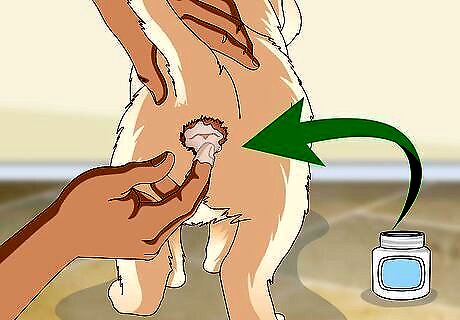
Rub petroleum jelly or baby oil on the probe. Apply the lubricant to the end of the probe that will go into your dog’s rectum. This end will usually have a metal cap on it. You can buy petroleum jelly or baby oil at grocery stores.

Hold the dog still. Make sure to praise the dog and soothe it throughout the process. If possible, ask someone else to hold the dog’s muzzle and pet it while you take its temperature. Have the second person stand or kneel next to the dog. They should slip the elbow furthest from the dog under its chin, and hook the closer arm under it chest just behind the front feet. This is a safe and comfortable hold.
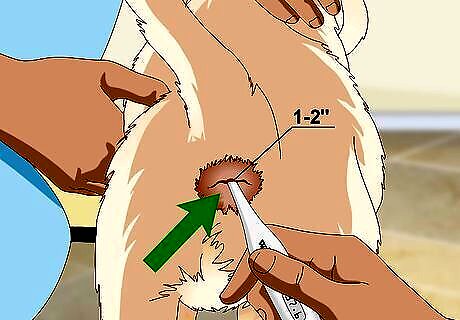
Insert the probe 1–2 inches (2.5–5.1 cm) into the dog’s rectum. Lift the dog's tail out of the way if necessary. Be gentle as you do this. Don’t force the thermometer in.
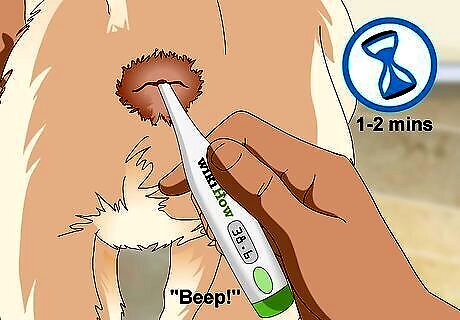
Wait 1-2 minutes. Digital thermometers will beep after a minute when they have finished. Old fashioned glass thermometers may need slightly more time. When time is up, remove the thermometer from the dog’s rectum.

Read the temperature off the thermometer. Digital thermometers will display the temperature on the screen at the top of the thermometer. For glass thermometers, read the number next to the highest point of the red line. A normal dog temperature is between 99.5–102.5 °F (37.5–39.2 °C). If your dog’s temperature is above or below this, call your vet. If the dog’s temperature is 104 °F (40 °C) or higher, take it immediately to the vet for emergency treatment.
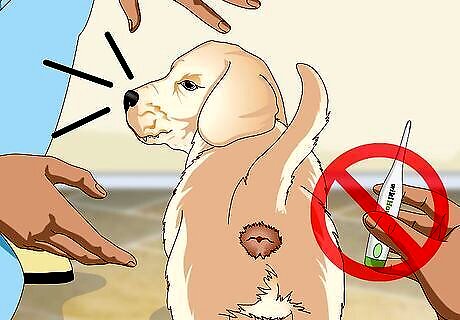
Stop taking its temperature if your dog reacts aggressively. Dogs may not like to have their temperature taken. Sick dogs especially may growl or snap at you. In this case, stop taking its temperature. Look for other symptoms of a fever instead.
Taking Temperature by Ear

Calibrate a digital dog ear thermometer. Follow the instructions for your digital ear thermometer to calibrate it. In most cases, it will calibrate automatically. Just turn on the thermometer and wait a few seconds until it beeps. Do not use a glass thermometer when taking temperature by ear. You will not receive an accurate reading. There is no need to lubricate an ear thermometer. You can get canine ear thermometers from your vet, a pet store, or online.
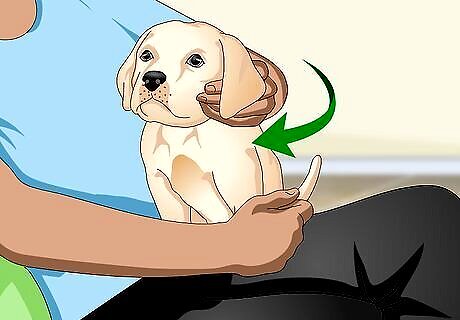
Hold your dog’s head still in your lap. If needed, lift up the dog's ear. Pet the dog with whichever hand is not managing the thermometer. If possible, have another person hold the dog still while you take its temperature.
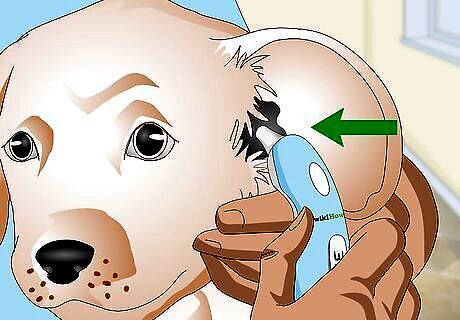
Insert the probe horizontally into the ear canal. Hold the probe straight as you insert it into the dog’s ear. It should be at a 90-degree angle to the dog’s head.

Hold the probe in the dog’s ear until it beeps. This may take between 1-2 minutes, depending on the brand. Try to keep the probe inside your dog’s ear for the entire duration. If your dog tries to move away or if the probe falls out, try again.

Read the temperature off the digital screen. The temperature will appear at the top of the thermometer. Normal temperature for a dog is between 99.5–102.5 °F (37.5–39.2 °C). If your dog’s temperature is above or below this, call your vet. A temperature above 104 °F (40 °C) is a medical emergency. Take your dog to the vet immediately.
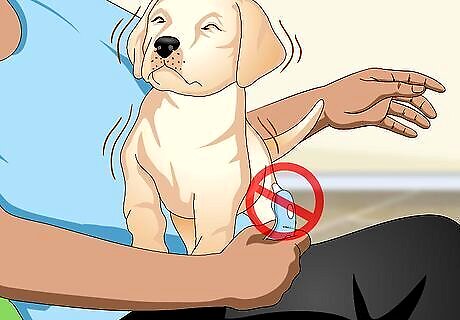
Stop the process if your dog whines or snaps. If your dog has an ear infection, using an ear thermometer can be painful. Stop if the dog yelps, whines, or shows other signs of pain. Similarly, if your dog reacts aggressively, stop what you are doing. Check the dog for physical symptoms of a fever instead.
Checking for Fever without a Thermometer
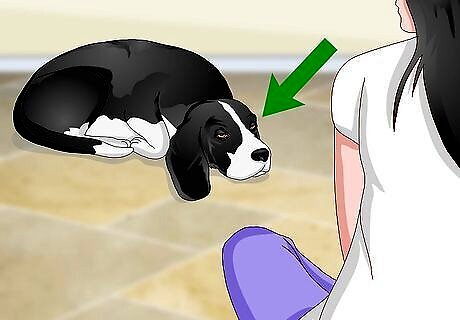
Look for lethargic or depressed behavior from your dog. If your dog is not as energetic as usual, there may be something wrong. It may seem sad or depressed. It may sleep for longer than usual or refuse to play. This could be a sign of either a high or low temperature.

Watch for shivering or panting. If the dog has a fever, it may pant heavily even while resting. Alternatively, it may visibly shake or you may feel the dog shiver when you touch it.
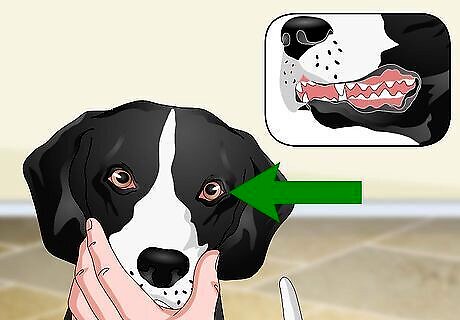
Examine the dog's eyes and gums for redness. If your dog’s eyes appear red and inflamed, it may be a sign of illness, such as a fever or allergy. Check its gums as well. Normal healthy gums should look light pink. A dog with a fever may have dark, red gums.

Listen for coughing from the dog. Like humans, dogs may cough when they are sick. Coughing usually indicates a respiratory infection, which could cause a fever. Take your dog to the vet.
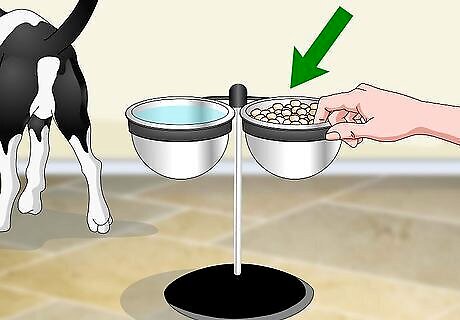
Track its food and water intake to see if it has lost its appetite. If a dog stops eating suddenly, it’s usually a sign of a problem. A dog with a fever may lose its appetite, even if you try to encourage it to eat. Call your vet for advice.
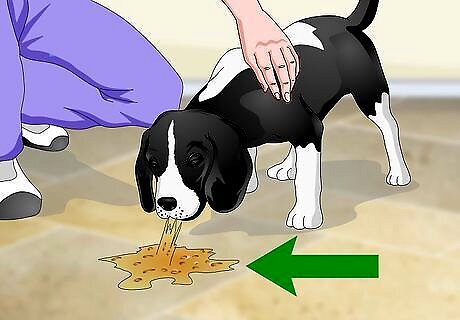
Monitor any vomiting. If your dog vomits, withhold food for a few hours to see if it gets better. If it vomits again during this time, take your dog to the vet. The vet can perform tests to see what is causing the vomiting.

Take your dog to the vet if it displays multiple symptoms. Any 1 of these symptoms does not necessarily mean that your dog has a fever. If it's displaying more than 1 symptom, take your dog to the vet just in case. Your dog may have a fever or another condition. If your dog vomits twice in 1 day, take it to the vet regardless.




















Comments
0 comment